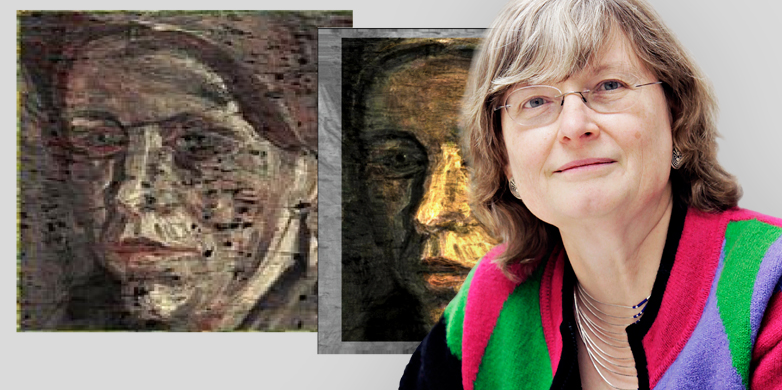Using applied mathematics to track down counterfeits
At this year’s Pauli Lectures, mathematics professor Ingrid Daubechies will offer an insight into her research on wavelets and digital signal processing. Among other applications, she uses these two fields to unequivocally identify forged Van Goghs.
As a child, Ingrid Daubechies actually wanted to follow in her father’s footsteps and become an engineer. But her affinity for mathematics and solving complex mathematical problems led her down a different path. Before long, she was studying physics at the Vrije Universiteit in Brussels, where she also completed a doctorate in theoretical physics. After that, she embarked on a remarkable career that would see her take positions at, among others, AT&T Bell Laboratories, New York University, and Princeton University, where she was the first ever female mathematics professor. Today she is engaged in research and teaching at Duke University in Durham, USA, and from 2011 to 2015 she served as President of the International Mathematical Union – again as the first woman to ever hold the position.
Co-inventor of JPEG 2000
Daubechies has achieved worldwide renown above all for her work in the field of wavelets and their use for digital image processing. The image format JPEG 2000 – a more-versatile and more-complex version of the common JPEG format – is largely based on Daubechies’ research successes. Today the standard is even used by the FBI to record images of fingerprints.
Wavelets are elementary functions. When combined, they can be used as an efficient way to represent general functions – or signals – and in particular their local properties. For Daubechies, images are nothing more than functions with two variables, as every high-resolution digital image is made up of thousands of pixels, the smallest units of an image. Each of these pixels is described mathematically: as a greyscale in black and white images and as an exact pixel colour in colour images. From these sequences of numbers, computers or smartphones can generate the actual image we see on the screen.
Virtual art restoration
In her research, Daubechies often uses a method referred to as ‘wavelet decomposition’, whereby an image is broken down into tiny parts that, together, describe what can be seen in an image. In this process, she focuses above all on areas of the image where the pixels differ strongly from one another, as it is precisely these features that make an image unique. Daubechies briefly demonstrated the practical application of such methods in Ghent. The Ghent Altarpiece in St Bavo’s Cathedral is a 15th-century winged altarpiece by artist Jan van Eyck. Consisting of 12 individual images, it is considered a fundamental masterpiece in Western European art history. Like most works from this era, the images are scattered with tiny cracks and fractures as a result of variations in temperature and humidity.
On request, Daubechies’ research group produced a virtual restoration of the piece. To do this, the group developed an image-processing algorithm that was then used to automatically detect and remove the fractures in a high-resolution photograph of the original image. The result was a restored, digital representation of the Ghent Altarpiece. This virtual restoration allowed art historians to better interpret the image: for example, they were able to decipher more words on a medieval book that the artist had depicted in the original image, allowing them to uncover new references.
Computing the real Van Gogh
In cooperation with the Van Gogh Museum in Amsterdam and an interdisciplinary research team, Daubechies was also able to prove that signal analysis of the tiniest image sections can be used to identify counterfeits. Specifically, experts noticed that the brushstrokes of even the best forgers differ slightly from those of the master. The paints are applied slightly more hesitantly and slowly. Daubechies and her colleagues therefore developed an image-processing algorithm that looked for precisely this information. A television station commissioned the group to identify the one counterfeit from six Van Gogh paintings using their image analysis technique. They succeeded on their first attempt.
“Ingrid Daubechies has made fundamental contributions to the field of digital signal processing with practical applications,” says Marc Burger, a professor at the Department of Mathematics and organiser of this year’s Pauli Lectures. “We were also particularly impressed with the mixture of art, experimental science and mathematics that characterises a number of her research contributions. We are therefore delighted that she is giving this year’s Pauli Lectures.” In the first of the three lectures at ETH on 26 October, Daubechies will focus on her research in cooperation with art historians and art conservators, and analyse the underlying mathematics. In two subsequent presentations, the professor will address new applications for signal processing in biology as well as new photo compression technologies that allow images to be stored and distributed online more easily and more efficiently.
Pauli Lectures 2015
The Wolfgang Pauli Lectures, a three-part lecture series, have been held annually since 1962. They are dedicated, in turn, to physics, mathematics and biology. The Pauli Lectures offer a forum for distinguished speakers to present their pioneering research. The lecture series is named after the theoretical physicist and Nobel laureate Wolfgang Pauli, who was a professor at ETH Zurich from 1928 until his death in 1958.
The Pauli Lectures 2015 will be held on 26, 27 and 29 October at 8:15 pm in the Auditorium Maximum (F 30) at the ETH Zurich main building on Rämistrasse 101, Zurich. The lectures are open to the public and are aimed at a wide audience with an interest in natural sciences. They are held in English. Entrance is free and prior registration is not necessary.
Monday, 26 October: Mathematicians helping Art Historians and Art Conservators
Tuesday, 27 October: Lovely Bones: a Meeting of Mathematical and Biological Minds
Thursday, 29 October: Surfing with Wavelets
For further information, please visit www.pauli-lectures.ethz.ch

